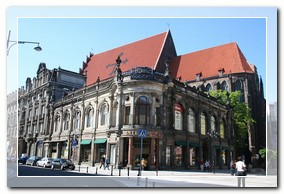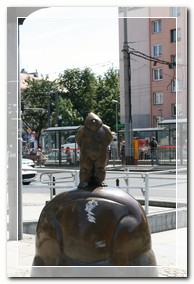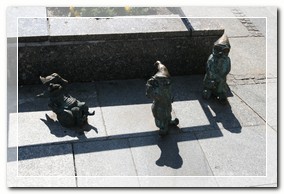


 The Swidnicka street, which owes its name to the fact
that on its whole one km lenght it runs towards Swidnica - a city
situated 30km from Wroclaw - was built in the Middle Ages together with
other smaller backstreets around the market and the first record of it
comes from 1303. It was finished once with the fortificated Swidnicka
Gate, which was demolished together with the majority of the defensive
walls after the siege of Wroclaw by Napoleon's armies. It is an
exquisite example of coexistence of styles, imposing on oneself in the
The Swidnicka street, which owes its name to the fact
that on its whole one km lenght it runs towards Swidnica - a city
situated 30km from Wroclaw - was built in the Middle Ages together with
other smaller backstreets around the market and the first record of it
comes from 1303. It was finished once with the fortificated Swidnicka
Gate, which was demolished together with the majority of the defensive
walls after the siege of Wroclaw by Napoleon's armies. It is an
exquisite example of coexistence of styles, imposing on oneself in the  next periods of the history of the city.
We will find here a great concrete "box of matches" — long, block of
flats standing near the market, the postmodernist department store
Solpol, kept in the tint of furious violet, but also a lot of priceless
historical monuments, with which many legends, stories and anecdotes are
connected. To the most interesting, though not the only ones worth
looking at, belong:
next periods of the history of the city.
We will find here a great concrete "box of matches" — long, block of
flats standing near the market, the postmodernist department store
Solpol, kept in the tint of furious violet, but also a lot of priceless
historical monuments, with which many legends, stories and anecdotes are
connected. To the most interesting, though not the only ones worth
looking at, belong:
- The Gothic Church under the call of saint Stanislas, saint Dorothy and saint Wenceslas
- The Gothic God's Body Church
- The exquisite neoclassical Wroclaw's Opera from 1841.
- The neobaroque hotel Monopoly from 1899.
- The neoreneissance guardroom
- The promenade near the municipal moat
In the 70's of the XX century the Swidnicka street was crossed by a
transit rout, on the needs of which the antique tenements lying on the  rout were demolished. An underground
passage was made under it, because of very wide and low stairs called
the stairs of odd steps. It constituted a place of political
pronouncements of the Orange Alternative, opposition to the communism
symbolized with an orange gnome, commemorated today with a dwarf
monument on it's north side.
rout were demolished. An underground
passage was made under it, because of very wide and low stairs called
the stairs of odd steps. It constituted a place of political
pronouncements of the Orange Alternative, opposition to the communism
symbolized with an orange gnome, commemorated today with a dwarf
monument on it's north side.
It is worth to turn from the Swidnicka street into an exquisite promenade over the municipal moat, which came into existence in place of demolished defensive walls.

















